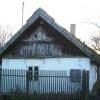The village was rebuilt in the 18th century in today's Hunyadi János Street (in the 19th century at Nagy Street), at Kontra Street and Rozmaring Street. The living area consists predominantly of individual plots. The dwelling houses were mostly placed at the end of the street, at the border of the plot, so-called. comb installation, because the utilization of the port was the most favorable. The array of gems that are formed in this way, though different, still provide a single street view. In addition to the centuries-old tradition of comb installation, buildings have been placed parallel to the street. Mainly craftsmen and merchants favored the connection between the sales area and the street. In the old part of the settlement there are many well-kept, hundreds of years old, thatched cottages are the monuments of folk architecture. It is worth mentioning that in 1896, the village of Szeged was built in the ethnographic village of the national millennium exhibition, representing the folk architecture of the Csongrád County.
Intro



